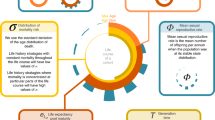Abstract
Mechanisms of survival fall into two broad categories. To survive in the short term animals must, of course, be adapted to the particular environments in which they live. However, other properties of animal populations can be regarded as “adaptations to the pattern of the environment in space and time” (Levins, 1968) involving flexibility of response to environmental factors, and it is these adaptations which are categorised as strategies. Efficiency and stability are the two features necessary for survival under natural selection (MacArthur, 1955) and it is the purpose of this paper to discuss certain aspects of the ecology of meiofauna populations and communities which ensure the fulfillment of these two criteria.
Access this chapter
Tax calculation will be finalised at checkout
Purchases are for personal use only
Preview
Unable to display preview. Download preview PDF.
Similar content being viewed by others
References
Battaglia, B. 1964. Advances and problems of ecological genetics in marine animals, p. 451–461. In: Genetics Today. Pergamon Press.
Cullen, D.J. 1973. Bioturbation of superficial marine sediments by interstitial meiobenthos. Nature, 242: 323–324.
Fava, G. and Crotti, E. 1979. Effect of crowding on nauplii production during mating time in Tisbe clodiensis and Tholothuriae (Copepoda, Harpacticoida). Helgolander wis’s Meersunters. 32: 466–475.
Gerlach, S.A. 1977. Means of meiofauna dispersal. Mikrofauna Meeresboden, 61: 89–103.
Gerlach, S.A. 1978. Food-chain relationships in subtidal silty sand marine sediments and the role of meiofauna in stimulating bacterial productivity. Oecologia, 33: 55–69.
Gray, J.S. 1978. The structure of meiofauna communities. Sarsia, 64: 265–272.
Lee, J.J. 1974. Towards understanding the niche of foraminifera. p. 207–260. In: R.H. Hedley & C.G. Adams (eds.), Foraminifera Volume 1. Academic Press.
Levins, R. 1968. Evolution in changing environments. Some theoretical explorations. Monographs in Population Biology, 2: Princeton University Press.
MacArthur, R.H. 1955. Fluctuations of animal populations and a measure of community stability. Ecology 36: 533–536.
Mclntyre, A.D. 1971. Control factors on meiofauna populations. Thalassia Jugoslavica, 7: 209–215.
Paine, R.T. 1966. Food web complexity and species diversity. Am. Nat. 100: 65–75.
Penter, D.M. 1969. The ecology of intertidal harpacticoids in the Swale, North Kent. Ph.D. Thesis, University of London.
Price, R. and Warwick, R.M. 1980. The effect of temperature on the respiration rate of meiofauna. Oecologia, 44: 145–148.
Reise, K. and Ax, P. 1979. A meiofaunal “thiobios” limited to the anaerobic sulfide system of marine sand does not exist. Mar. Biol. 54: 225–237.
Riemann, F. and Schrage, M. 1978. The mucustrap hypothesis on feeding of aquatic nematodes and implications for biodegradation and sediment texture. Oecologia 34: 75–88.
Sprey, B. 1970. Die Lokalisierung von Sekundarcorotinoiden von Haematococcus pluvialis Flotow em. Wille. Protoplasma, 71: 235–250.
Teare, M.J. 1978. An energy budget for Tachidius discipes (Copepoda Harpacticoida) from an estuarine mudflat. Ph.D. Thesis, University of Exeter.
Tietjen, J.H. and Lee, J.J. 1977. Feeding behaviour of marine nematodes, p. 21–36. In: B.C. Coull (ed.), Ecology of marine benthos. University of South Carolina Press.
Warwick, R.M. 1980. Population dynamics and secondary production of benthos, p. 1–24. In: K.R. Tenore and B.C. Coull (eds.), Marine benthic dynamics. University of South Carolina Press.
Warwick, R.M., Joint, I.R. and Radford, P.J. 1979. Secondary production of the benthos in an estuarine environment, p. 429–450. In: R.L. Jefferies and A.J. Davey (eds.), Ecological Processes in Coastal Environments. Blackwell.
Warwick, R.M. and Price, R. 1979. Ecological and metabolic studies on free-living nematodes from an estuarine mud-flat. Est, coastl. mar. Sci. 9: 257–271.
Author information
Authors and Affiliations
Editor information
Editors and Affiliations
Rights and permissions
Copyright information
© 1981 Plenum Press, New York
About this chapter
Cite this chapter
Warwick, R.M. (1981). Survival Strategies of Meiofauna. In: Jones, N.V., Wolff, W.J. (eds) Feeding and Survival Srategies of Estuarine Organisms. Marine Science, vol 15. Springer, Boston, MA. https://doi.org/10.1007/978-1-4613-3318-0_4
Download citation
DOI: https://doi.org/10.1007/978-1-4613-3318-0_4
Publisher Name: Springer, Boston, MA
Print ISBN: 978-1-4613-3320-3
Online ISBN: 978-1-4613-3318-0
eBook Packages: Springer Book Archive




